engine coolant Acura TL 2000 3.2 User Guide
[x] Cancel search | Manufacturer: ACURA, Model Year: 2000, Model line: TL, Model: Acura TL 2000Pages: 311, PDF Size: 3.05 MB
Page 203 of 311
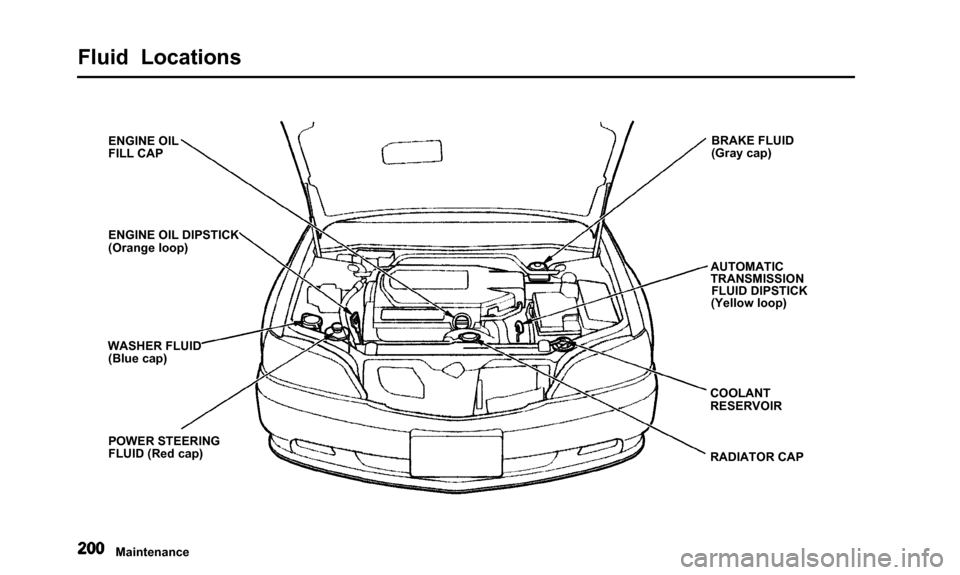
Fluid Locations
ENGINE OIL
FILL CAP
ENGINE OIL DIPSTICK
(Orange loop)
WASHER FLUID (Blue cap)
POWER STEERING
FLUID (Red cap) BRAKE FLUID
(Gray cap)
AUTOMATIC
TRANSMISSION FLUID DIPSTICK
(Yellow loop)
COOLANT
RESERVOIR
RADIATOR CAP
Maintenance
Page 209 of 311

Cooling System
Adding Engine Coolant
RESERVE TANK
If the coolant level in the reserve
tank is at or below the MIN line, add
coolant to bring it up to the MAX line.Inspect the cooling system for leaks.
This coolant should always be a mixture of 50 percent antifreeze and50 percent water. Never add straight
antifreeze or plain water. Always use Genuine Honda
Antifreeze/Coolant. If it is not
available, you may use another
major-brand non-silicate coolant as a
temporary replacement. Make sure it
is a high-quality coolant
recommended for aluminum engines.
However, continued use of any non-
Honda coolant can result in corrosion, causing the cooling
system to malfunction or fail. Have
the cooling system flushed and refilled with Honda antifreeze/
coolant as soon as possible. If the reserve tank is completely
empty, you should also check the
coolant level in the radiator.
Maintenance
Page 210 of 311

Cooling System
Removing the radiator cap
while the engine is hot can
cause the coolant to spray out,
seriously scalding you.
Always let the engine and radiator cool down beforeremoving the radiator cap.RADIATOR CAP
1. Make sure the engine and radiator
are cool.
2. Turn the radiator cap counter- clockwise, without pressing down
on it, until it stops. This relieves
any pressure remaining in the
cooling system. 3. Remove the radiator cap by
pushing down and turningcounterclockwise.
CONTINUED
Maintenance
Page 211 of 311

Cooling System
4. The coolant level should be up tothe base of the filler neck. Add
coolant if it is low.
5. Put the radiator cap back on. Tighten it fully.
RESERVE TANK
6. Pour coolant into the reserve tank. Fill it to halfway between the MAX
and MIN marks. Put the cap back on the reserve tank.
Do not add any rust inhibitors or other additives to your car's cooling
system. They may not be compatible
with the coolant or engine compo- nents. Replacing Engine Coolant
The cooling system should be completely drained and refilled with
new coolant according to the timeand distance recommendations in
the maintenance schedule. Only use Genuine Honda Antifreeze/Coolant.
Draining the coolant requires access
to the underside of the car. Unless
you have the tools and knowledge,
you should have this maintenance done by a skilled mechanic.
Maintenance
Page 212 of 311

Cooling System
1. Turn the ignition ON (II). Turnthe heater temperature controldial to maximum heat (climate
control to 90°F/32°C). Turn off
the ignition. Open the hood. Make sure the engine and radiator are
cool to the touch.
2. Remove the radiator cap.
DRAIN PLUG
DRAIN BOLT
3. Loosen the drain plug on thebottom of the radiator. Thecoolant will drain through thesplash guard. Loosen the drain
bolt at the rear of the engine cylinder block.
RESERVE TANK CAP RESERVE TANK
HOLDER
4. Remove the reserve tank from itsholder by pulling it straight up.Drain the coolant, then put the
tank back in its holder.
5. When the coolant stops draining, tighten the drain plug at the
bottom of the radiator.
CONTINUED
Maintenance
Page 213 of 311
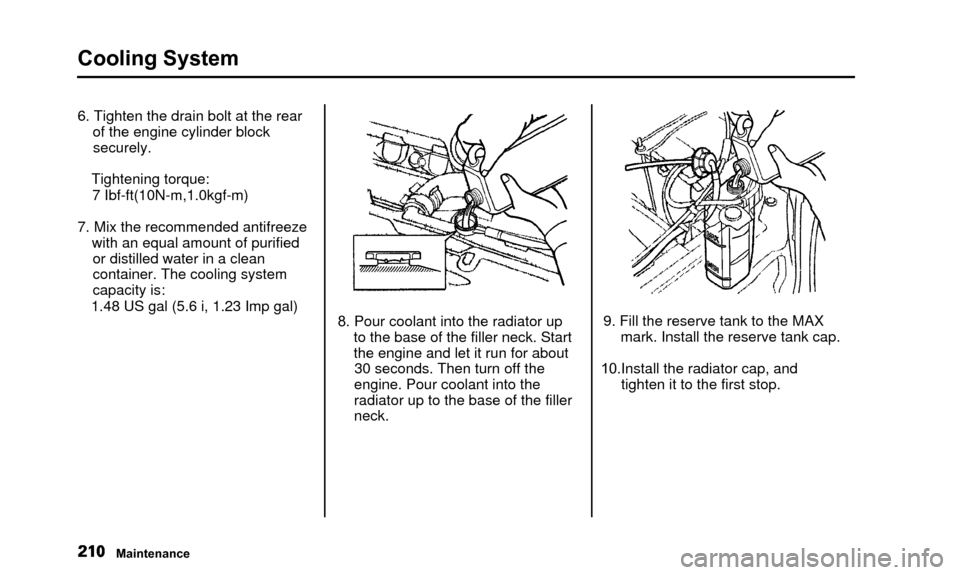
Cooling System
6. Tighten the drain bolt at the rearof the engine cylinder blocksecurely.
Tightening torque: 7 Ibf-ft(10N-m,1.0kgf-m)
7. Mix the recommended antifreeze with an equal amount of purifiedor distilled water in a clean
container. The cooling system
capacity is:
1.48 US gal (5.6 i, 1.23 Imp gal) 8. Pour coolant into the radiator up
to the base of the filler neck. Start
the engine and let it run for about30 seconds. Then turn off the
engine. Pour coolant into the
radiator up to the base of the filler
neck. 9. Fill the reserve tank to the MAX
mark. Install the reserve tank cap.
10.Install the radiator cap, and tighten it to the first stop.
Maintenance
Page 214 of 311

Cooling System
11.Start the engine and hold it at1,500 rpm until the radiatorcooling fan comes on at least twice.
Then stop the engine.
12.Remove the radiator cap. Pour coolant into the radiator up to thebase of the filler neck and into the
reserve tank up to the MAX mark.
13.Start the engine and hold it at 1,500 rpm until the cooling fancomes on. Turn off the engine. Check the coolant level in the radiator and add coolant if needed.
14.Install the radiator cap, and tighten it fully. 15.If necessary, fill the reserve tank
to the MAX mark. Install thereserve tank cap.
Maintenance
Page 268 of 311
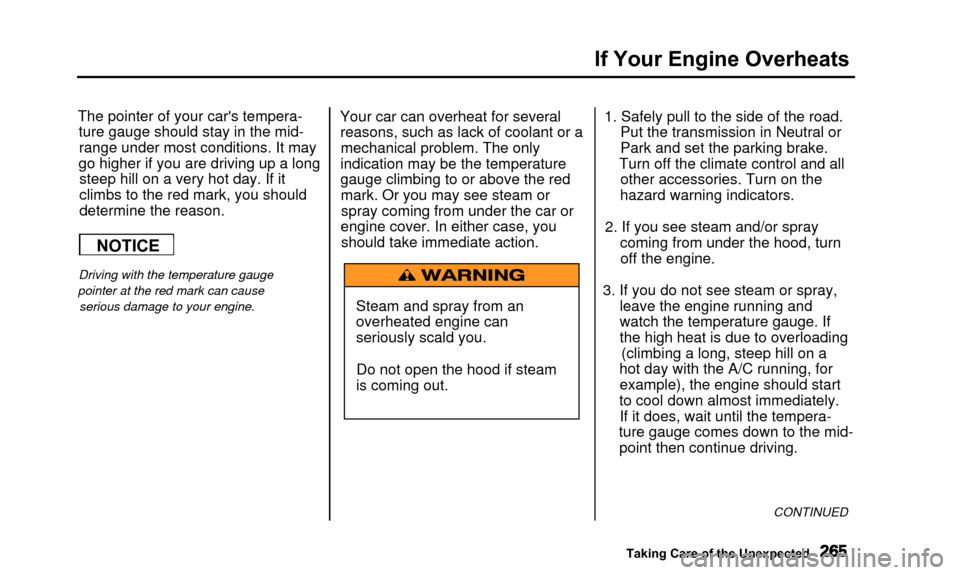
If Your Engine Overheats
The pointer of your car's tempera-ture gauge should stay in the mid-range under most conditions. It may
go higher if you are driving up a long steep hill on a very hot day. If it
climbs to the red mark, you should
determine the reason.
Driving with the temperature gauge
pointer at the red mark can cause serious damage to your engine.
Your car can overheat for severalreasons, such as lack of coolant or amechanical problem. The only
indication may be the temperature
gauge climbing to or above the red mark. Or you may see steam orspray coming from under the car or
engine cover. In either case, you should take immediate action.
Steam and spray from an
overheated engine can
seriously scald you.Do not open the hood if steam
is coming out. 1. Safely pull to the side of the road.
Put the transmission in Neutral or
Park and set the parking brake.
Turn off the climate control and all other accessories. Turn on the
hazard warning indicators.
2. If you see steam and/or spray coming from under the hood, turnoff the engine.
3. If you do not see steam or spray, leave the engine running and
watch the temperature gauge. If
the high heat is due to overloading(climbing a long, steep hill on a
hot day with the A/C running, for example), the engine should start
to cool down almost immediately. If it does, wait until the tempera-
ture gauge comes down to the mid- point then continue driving.
CONTINUED
Taking Care of the Unexpected
NOTICE
Page 269 of 311
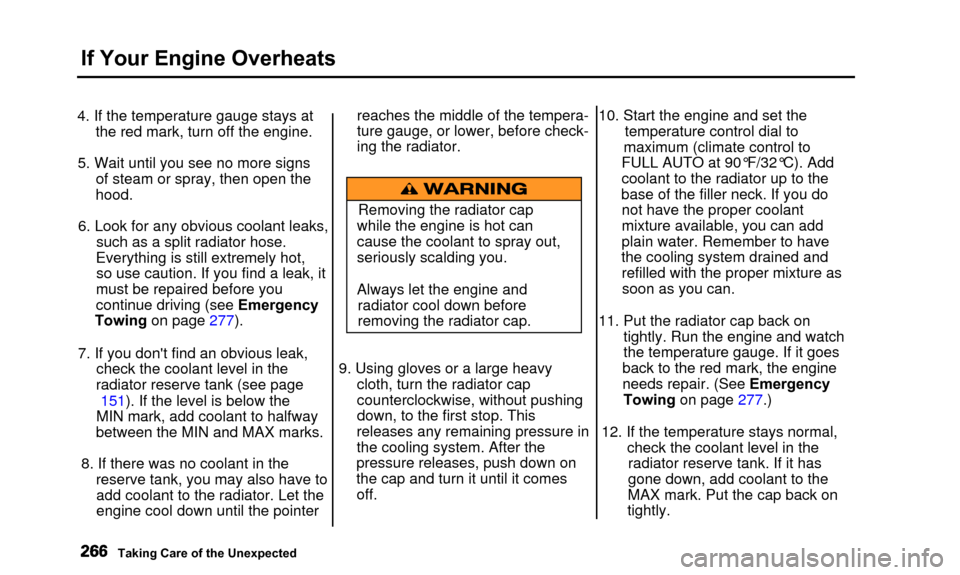
If Your Engine Overheats
4. If the temperature gauge stays atthe red mark, turn off the engine.
5. Wait until you see no more signs of steam or spray, then open the
hood.
6. Look for any obvious coolant leaks, such as a split radiator hose.
Everything is still extremely hot, so use caution. If you find a leak, it
must be repaired before you
continue driving (see Emergency
Towing on page 277).
7. If you don't find an obvious leak, check the coolant level in the
radiator reserve tank (see page
151). If the level is below the
MIN mark, add coolant to halfway
between the MIN and MAX marks.
8. If there was no coolant in the reserve tank, you may also have toadd coolant to the radiator. Let the
engine cool down until the pointer reaches the middle of the tempera-
ture gauge, or lower, before check-
ing the radiator.
Removing the radiator cap
while the engine is hot can
cause the coolant to spray out,
seriously scalding you.
Always let the engine and radiator cool down before
removing the radiator cap.
9. Using gloves or a large heavy cloth, turn the radiator cap
counterclockwise, without pushing
down, to the first stop. This
releases any remaining pressure in
the cooling system. After the
pressure releases, push down on
the cap and turn it until it comes off. 10. Start the engine and set the
temperature control dial to
maximum (climate control to
FULL AUTO at 90°F/32°C). Add
coolant to the radiator up to the
base of the filler neck. If you do not have the proper coolant
mixture available, you can add
plain water. Remember to have
the cooling system drained and refilled with the proper mixture assoon as you can.
11. Put the radiator cap back on tightly. Run the engine and watch
the temperature gauge. If it goes
back to the red mark, the engine
needs repair. (See Emergency
Towing on page 277
.)
12. If the temperature stays normal, check the coolant level in theradiator reserve tank. If it has
gone down, add coolant to the
MAX mark. Put the cap back on
tightly.
Taking Care of the Unexpected
Page 285 of 311
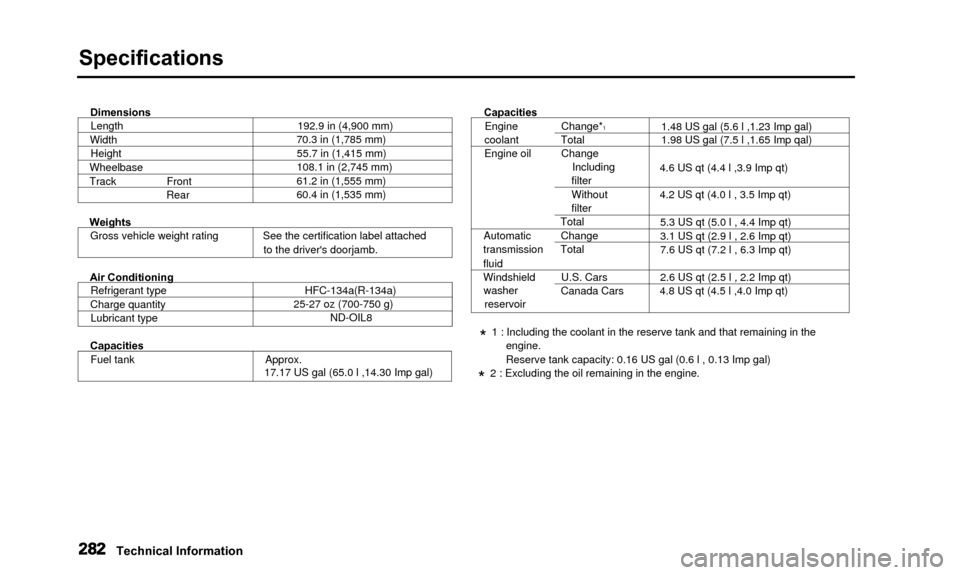
Specifications
DimensionsLength
Width Height
Wheelbase
Track Front Rear 192.9 in (4,900 mm)
70.3 in (1,785 mm)
55.7 in (1,415 mm)
108.1 in (2,745 mm)
61.2 in (1,555 mm)
60.4 in (1,535 mm) Capacities
Weights
Gross vehicle weight rating See the certification label attached to the driver's doorjamb.
Air Conditioning
Refrigerant type
Charge quantity Lubricant type HFC-134a(R-134a)
25-27 oz (700-750 g) ND-OIL8
Engine
coolant
Engine oil
Automatic
transmission
fluid
Windshield washer
reservoir Change*1Total
Change Including
filter
Without
filter
Total
Change
Total
U.S. Cars
Canada Cars 1.48 US gal (5.6 l ,1.23 Imp gal)
1.98 US gal (7.5 l ,1.65 Imp qal)
4.6 US qt (4.4 l ,3.9 Imp qt)
4.2 US qt (4.0 l , 3.5 Imp qt) 5.3 US qt (5.0 l , 4.4 Imp qt)
3.1 US qt (2.9 l , 2.6 Imp qt)
7.6 US qt (7.2 l , 6.3 Imp qt)
2.6 US qt (2.5 l , 2.2 Imp qt)
4.8 US qt (4.5 l ,4.0 Imp qt)
Capacities
Fuel tank Approx. 17.17 US gal (65.0 l ,14.30 Imp gal)
* 1 : Including the coolant in the reserve tank and that remaining in the
engine.
Reserve tank capacity: 0.16 US gal (0.6 l , 0.13 Imp gal)
* 2 : Excluding the oil remaining in the engine.
Technical Information